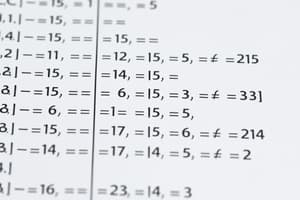Podcast
Questions and Answers
Identify the level of measurement for the variable 'Monthly salary'.
Identify the level of measurement for the variable 'Monthly salary'.
Ratio
Classify the variable 'Religion' as either quantitative or qualitative.
Classify the variable 'Religion' as either quantitative or qualitative.
Qualitative
What is the level of measurement for the variable 'Soap Brand'?
What is the level of measurement for the variable 'Soap Brand'?
Nominal
Explain the difference between primary and secondary sources of data.
Explain the difference between primary and secondary sources of data.
Provide an example of a variable measured on an interval scale.
Provide an example of a variable measured on an interval scale.
Flashcards
Discrete Variables
Discrete Variables
Isolated, countable values like the number of persons.
Continuous Variables
Continuous Variables
Variables that can take any value within a range, like age and weight.
Nominal Scale
Nominal Scale
A qualitative measurement that consists of categories without order.
Ordinal Scale
Ordinal Scale
Signup and view all the flashcards
Quantitative Variables
Quantitative Variables
Signup and view all the flashcards
Study Notes
Types of Variables
- Discrete Variables: Isolated values, usually countable. Example: Number of persons.
- Continuous Variables: Can take any value within a range, uncountable. Examples include age, weight, and BMI.
Classification of Variables
- Monthly Salary: Quantitative
- Religion: Qualitative
- Soap Brand: Qualitative
- Temperature: Quantitative
- Occupation: Qualitative
- Food Flavor: Qualitative
- Color: Qualitative
- Wealth Status: Qualitative
- Weight: Quantitative
- Highest Education Level: Qualitative
- Duration of a Class: Quantitative
- Nationality: Qualitative
- Number of Family Members: Quantitative
- Satisfaction Level: Qualitative
Levels of Measurement
Qualitative Measurements
-
Nominal Scale:
- Consists of names or categories that cannot be ordered or numerically measured.
- Examples: Person's name, gender, place of residence, brand name.
-
Ordinal Scale:
- Refers to categories that can be ordered but are not numerically measured.
- Examples: Wealth status (poor, middle, rich), Education level (primary, secondary, higher).
Quantitative Measurements
- Interval Scale:
- Numerically measurable, allows for differences to be identified but not ratios; lacks a true zero point.
- Example: Temperature; 0°C does not indicate the absence of heat.
Definition of Variable
- A variable is a characteristic that contains two or more values or categories that can vary from one individual or object to another.
- Examples include gender, age, educational status, hair color, religion, monthly income, satisfaction level, soap brand, temperature, and GPA.
Possible Values for Variables
- Gender: Categories include Male, Female.
- Age: Possible values might range from 10 to 75 years.
- Highest Education Level: Categories such as Primary, Secondary, Higher.
- Number of Employees: Examples include 10, 50, 89, 125, 4562.
- Salary Duration: Various amounts like $1000, $10000, IR45000, BDT 98000, Rs.500000.
- Weight: Can include measures such as 45 lb., 60 kg, 900 gm, 5 ton.
- Wealth Status: Categories include Poor, Middle, Higher.
Additional Notes on Variables
- Quantitative Variables: Can be analyzed numerically (e.g., age, weight, monthly income, temperature).
- Qualitative Variables: Include categorical data (e.g., gender, religion, brand preference, satisfaction level).
Studying That Suits You
Use AI to generate personalized quizzes and flashcards to suit your learning preferences.



